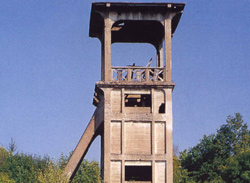
Boring of Saint Marie’s mine shaft began on April 1st 1864, at the foot of Bourlémont hill. 359 meters deep, through sandstone and red clay, this mine shaft produced very little coal.
In 1880, this concrete shaft became the main ventilation shaft for the other extraction shafts.
Its role gradually declined in importance and activity stopped. In 1921, the use of the Chanois shaft, not far off, boosted activity at the Saint Marie shaft. A new concrete pit head frame was installed in 1924.
In coal fields, ventilation is essential to fight against problems caused by:
After closure in 1958, the galleries of the Saint Marie shaft were filled in. Thanks to Doctor Maulini, doctor of the mine and founder of the Mining museum, it was not destroyed.
The site was fitted out and secured in 1994.
Today, the Saint Marie shaft is the only visible vestige of the mining activity in Ronchamp.